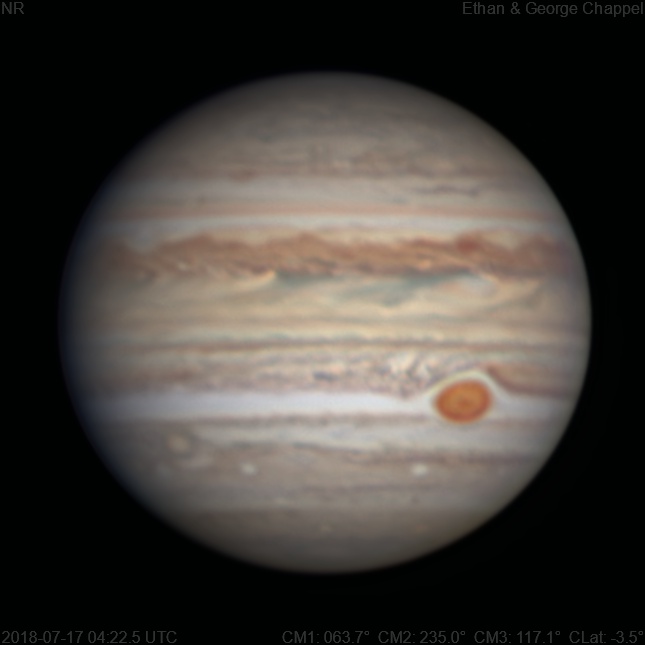
Jupiter UTC
CM1: 63.70°
CM2: 235.00°
CM3: 117.10°
CLat: -3.50°
Description
Seeing remained typical of what we've been seeing while imaging Jupiter the last few nights. Saharan dust limited transparency.
Notes:
- There's a brown spot in the North Temperate Zone that wasn't there on the 12th of July.
- The northern North Equatorial Belt is wavy.
- White Oval Z is rising.
- The Equatorial Zone is tinged orange.
- The Great Red Spot has a strong coloration.
- Oval BA and the STB Ghost are rising.
- The South Polar Red Spot is at a similar longitude as the GRS.
Equipment
Astro-Physics Advanced Convertible Barlow
Celestron EdgeHD 14
ZWO ASI290MM
Logs
FireCapture v2.6 Settings ------------------------------------ Observer=Ethan Chappel Location=Cibolo, TX, USA Scope=Celstron C14 EdgeHD Camera=ZWO ASI290MM Filter=R Profile=Jupiter Diameter=39.54" Magnitude=-2.20 CMI=172.6° CMII=321.2° CMIII=204.1° (during mid of capture) FocalLength=7800mm (F/21) Resolution=0.08" Filename=2018-07-17-0414_6-EC-R-Jup.ser Date=170718 Start=041336.639 Mid=041436.639 End=041536.639 Start(UT)=041336.639 Mid(UT)=041436.639 End(UT)=041536.639 Duration=120.000s Date_format=ddMMyy Time_format=HHmmss LT=UT -6h Frames captured=11992 File type=SER Binning=no Bit depth=8bit Debayer=no ROI=652x618 ROI(Offset)=8x8 FPS (avg.)=99 Shutter=10.00ms Gain=350 (58%) AutoGain=off HighSpeed=off FPS=100 (off) AutoHisto=75 (off) Gamma=50 (off) Brightness=1 (off) USBTraffic=40 (off) AutoExposure=off SoftwareGain=10 (off) Histogramm(min)=0 Histogramm(max)=126 Histogramm=49% Noise(avg.deviation)=2.60 Limit=120 Seconds Sensor temperature=34.7°C Focuser position=3050 FireCapture v2.6 Settings ------------------------------------ Observer=Ethan Chappel Location=Cibolo, TX, USA Scope=Celstron C14 EdgeHD Camera=ZWO ASI290MM Filter=G Profile=Jupiter Diameter=39.54" Magnitude=-2.20 CMI=174.2° CMII=322.7° CMIII=205.6° (during mid of capture) FocalLength=7800mm (F/21) Resolution=0.08" Filename=2018-07-17-0417_1-EC-G-Jup.ser Date=170718 Start=041609.327 Mid=041709.330 End=041809.333 Start(UT)=041609.327 Mid(UT)=041709.330 End(UT)=041809.333 Duration=120.006s Date_format=ddMMyy Time_format=HHmmss LT=UT -6h Frames captured=9995 File type=SER Binning=no Bit depth=8bit Debayer=no ROI=652x618 ROI(Offset)=8x8 FPS (avg.)=83 Shutter=12.00ms Gain=330 (55%) AutoGain=off HighSpeed=off FPS=100 (off) AutoHisto=75 (off) Gamma=50 (off) Brightness=1 (off) USBTraffic=40 (off) AutoExposure=off SoftwareGain=10 (off) Histogramm(min)=0 Histogramm(max)=122 Histogramm=47% Noise(avg.deviation)=2.20 Limit=120 Seconds Sensor temperature=34.8°C Focuser position=3050 FireCapture v2.6 Settings ------------------------------------ Observer=Ethan Chappel Location=Cibolo, TX, USA Scope=Celstron C14 EdgeHD Camera=ZWO ASI290MM Filter=B Profile=Jupiter Diameter=39.54" Magnitude=-2.20 CMI=176.1° CMII=324.6° CMIII=207.5° (during mid of capture) FocalLength=7850mm (F/22) Resolution=0.08" Filename=2018-07-17-0420_2-EC-B-Jup.ser Date=170718 Start=041917.442 Mid=042017.449 End=042117.457 Start(UT)=041917.442 Mid(UT)=042017.449 End(UT)=042117.457 Duration=120.015s Date_format=ddMMyy Time_format=HHmmss LT=UT -6h Frames captured=7496 File type=SER Binning=no Bit depth=8bit Debayer=no ROI=652x618 ROI(Offset)=8x8 FPS (avg.)=62 Shutter=16.00ms Gain=330 (55%) AutoGain=off HighSpeed=off FPS=100 (off) AutoHisto=75 (off) Gamma=50 Brightness=1 (off) USBTraffic=40 (off) AutoExposure=off SoftwareGain=10 (off) Histogramm(min)=0 Histogramm(max)=120 Histogramm=47% Noise(avg.deviation)=2.17 Limit=120 Seconds Sensor temperature=34.3°C Focuser position=2985 FireCapture v2.6 Settings ------------------------------------ Observer=Ethan Chappel Location=Cibolo, TX, USA Scope=Celstron C14 EdgeHD Camera=ZWO ASI290MM Filter=R Profile=Jupiter Diameter=39.54" Magnitude=-2.20 CMI=178.0° CMII=326.4° CMIII=209.4° (during mid of capture) FocalLength=7800mm (F/21) Resolution=0.08" Filename=2018-07-17-0423_3-EC-R-Jup.ser Date=170718 Start=042221.618 Mid=042321.624 End=042421.631 Start(UT)=042221.618 Mid(UT)=042321.624 End(UT)=042421.631 Duration=120.013s Date_format=ddMMyy Time_format=HHmmss LT=UT -6h Frames captured=11993 File type=SER Binning=no Bit depth=8bit Debayer=no ROI=652x618 ROI(Offset)=8x8 FPS (avg.)=99 Shutter=10.00ms Gain=350 (58%) AutoGain=off HighSpeed=off FPS=100 (off) AutoHisto=75 (off) Gamma=50 (off) Brightness=1 (off) USBTraffic=40 (off) AutoExposure=off SoftwareGain=10 (off) Histogramm(min)=0 Histogramm(max)=135 Histogramm=52% Noise(avg.deviation)=2.55 Limit=120 Seconds Sensor temperature=34.5°C Focuser position=3085 FireCapture v2.6 Settings ------------------------------------ Observer=Ethan Chappel Location=Cibolo, TX, USA Scope=Celstron C14 EdgeHD Camera=ZWO ASI290MM Filter=G Profile=Jupiter Diameter=39.54" Magnitude=-2.20 CMI=180.8° CMII=329.2° CMIII=212.1° (during mid of capture) FocalLength=7750mm (F/21) Resolution=0.08" Filename=2018-07-17-0427_9-EC-G-Jup.ser Date=170718 Start=042655.781 Mid=042755.788 End=042855.795 Start(UT)=042655.781 Mid(UT)=042755.788 End(UT)=042855.795 Duration=120.014s Date_format=ddMMyy Time_format=HHmmss LT=UT -6h Frames captured=9995 File type=SER Binning=no Bit depth=8bit Debayer=no ROI=652x618 ROI(Offset)=8x8 FPS (avg.)=83 Shutter=12.00ms Gain=330 (55%) AutoGain=off HighSpeed=off FPS=100 (off) AutoHisto=75 (off) Gamma=50 (off) Brightness=1 (off) USBTraffic=40 (off) AutoExposure=off SoftwareGain=10 (off) Histogramm(min)=0 Histogramm(max)=118 Histogramm=46% Noise(avg.deviation)=2.16 Limit=120 Seconds Sensor temperature=34.3°C Focuser position=0 FireCapture v2.6 Settings ------------------------------------ Observer=Ethan Chappel Location=Cibolo, TX, USA Scope=Celstron C14 EdgeHD Camera=ZWO ASI290MM Filter=B Profile=Jupiter Diameter=39.54" Magnitude=-2.20 CMI=183.2° CMII=331.7° CMIII=214.6° (during mid of capture) FocalLength=7800mm (F/21) Resolution=0.08" Filename=2018-07-17-0432_0-EC-B-Jup.ser Date=170718 Start=043100.731 Mid=043200.731 End=043300.731 Start(UT)=043100.731 Mid(UT)=043200.731 End(UT)=043300.731 Duration=120.000s Date_format=ddMMyy Time_format=HHmmss LT=UT -6h Frames captured=7495 File type=SER Binning=no Bit depth=8bit Debayer=no ROI=652x618 ROI(Offset)=8x8 FPS (avg.)=62 Shutter=16.00ms Gain=330 (55%) HighSpeed=off USBTraffic=40 (off) Gamma=50 FPS=100 (off) AutoHisto=75 (off) Brightness=1 (off) SoftwareGain=10 (off) AutoGain=off AutoExposure=off Histogramm(min)=0 Histogramm(max)=118 Histogramm=46% Noise(avg.deviation)=2.14 Limit=120 Seconds Sensor temperature=31.8°C